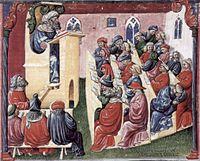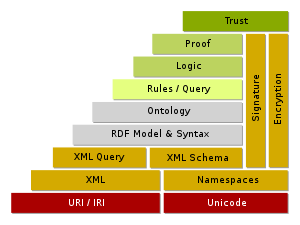 Image via WikipediaOne great thing that open source does is change how businesses work. Open textbooks are a great example. The publishers are doing a little too late in their attempt to fix the financial issues around textbook costs and the high cost of education. The New York Times reported earlier this year that trade and textbook publisher Macmillan is following the lead of open source publishers like Wikibooks, and is offering lower cost, editable textbooks online through their service DynamicBooks. They have disguised themselves well as an open source publisher. There is nothing on the website that would lead one to believe they are connected with Macmillan. There is the press release section in the "About us" menu item where you will find press releases and stories touting their idea as "ground-breaking" and "innovative" as if following the lead of open source is somehow a new idea. They are not really an open source option, of course: "Ms. Clancy of Macmillan said the publisher reserved the right to 'remove anything that is considered offensive or plagiarism,' and would rely on students, parents and other instructors to help monitor changes." That is really big of them to watch over us like that - in open source texts it is called "peer review" and instructors/authors are pretty good at citing their sources and not being concerned about offending others (that is called "academic freedom" for the instructors and "cognitive dissonance" for the students). On the plus side, Macmillan gets to take advantage of one part of the open source model and that is breaking out of the two year cycle for correcting mistakes in textbooks. In the end, book publishers need to make profits; educators facilitate learning. With the economy in the state that it is in, those are two diametrically opposed goals.
Image via WikipediaOne great thing that open source does is change how businesses work. Open textbooks are a great example. The publishers are doing a little too late in their attempt to fix the financial issues around textbook costs and the high cost of education. The New York Times reported earlier this year that trade and textbook publisher Macmillan is following the lead of open source publishers like Wikibooks, and is offering lower cost, editable textbooks online through their service DynamicBooks. They have disguised themselves well as an open source publisher. There is nothing on the website that would lead one to believe they are connected with Macmillan. There is the press release section in the "About us" menu item where you will find press releases and stories touting their idea as "ground-breaking" and "innovative" as if following the lead of open source is somehow a new idea. They are not really an open source option, of course: "Ms. Clancy of Macmillan said the publisher reserved the right to 'remove anything that is considered offensive or plagiarism,' and would rely on students, parents and other instructors to help monitor changes." That is really big of them to watch over us like that - in open source texts it is called "peer review" and instructors/authors are pretty good at citing their sources and not being concerned about offending others (that is called "academic freedom" for the instructors and "cognitive dissonance" for the students). On the plus side, Macmillan gets to take advantage of one part of the open source model and that is breaking out of the two year cycle for correcting mistakes in textbooks. In the end, book publishers need to make profits; educators facilitate learning. With the economy in the state that it is in, those are two diametrically opposed goals.THIS BLOG IS HERE FOR HISTORICAL PURPOSES ONLY - IT IS CONTINUED AT WWW.GEOFFCAIN.COM
Thursday, August 19, 2010
How Open Source Changes Business Models
 Image via WikipediaOne great thing that open source does is change how businesses work. Open textbooks are a great example. The publishers are doing a little too late in their attempt to fix the financial issues around textbook costs and the high cost of education. The New York Times reported earlier this year that trade and textbook publisher Macmillan is following the lead of open source publishers like Wikibooks, and is offering lower cost, editable textbooks online through their service DynamicBooks. They have disguised themselves well as an open source publisher. There is nothing on the website that would lead one to believe they are connected with Macmillan. There is the press release section in the "About us" menu item where you will find press releases and stories touting their idea as "ground-breaking" and "innovative" as if following the lead of open source is somehow a new idea. They are not really an open source option, of course: "Ms. Clancy of Macmillan said the publisher reserved the right to 'remove anything that is considered offensive or plagiarism,' and would rely on students, parents and other instructors to help monitor changes." That is really big of them to watch over us like that - in open source texts it is called "peer review" and instructors/authors are pretty good at citing their sources and not being concerned about offending others (that is called "academic freedom" for the instructors and "cognitive dissonance" for the students). On the plus side, Macmillan gets to take advantage of one part of the open source model and that is breaking out of the two year cycle for correcting mistakes in textbooks. In the end, book publishers need to make profits; educators facilitate learning. With the economy in the state that it is in, those are two diametrically opposed goals.
Image via WikipediaOne great thing that open source does is change how businesses work. Open textbooks are a great example. The publishers are doing a little too late in their attempt to fix the financial issues around textbook costs and the high cost of education. The New York Times reported earlier this year that trade and textbook publisher Macmillan is following the lead of open source publishers like Wikibooks, and is offering lower cost, editable textbooks online through their service DynamicBooks. They have disguised themselves well as an open source publisher. There is nothing on the website that would lead one to believe they are connected with Macmillan. There is the press release section in the "About us" menu item where you will find press releases and stories touting their idea as "ground-breaking" and "innovative" as if following the lead of open source is somehow a new idea. They are not really an open source option, of course: "Ms. Clancy of Macmillan said the publisher reserved the right to 'remove anything that is considered offensive or plagiarism,' and would rely on students, parents and other instructors to help monitor changes." That is really big of them to watch over us like that - in open source texts it is called "peer review" and instructors/authors are pretty good at citing their sources and not being concerned about offending others (that is called "academic freedom" for the instructors and "cognitive dissonance" for the students). On the plus side, Macmillan gets to take advantage of one part of the open source model and that is breaking out of the two year cycle for correcting mistakes in textbooks. In the end, book publishers need to make profits; educators facilitate learning. With the economy in the state that it is in, those are two diametrically opposed goals.Friday, August 13, 2010
Good Teaching is Accessible and Open
 Image via WikipediaI don't think Dave Arnold planned on being an innovator in education. The way I understand his work is that he had problems to solve with his math department and they are using every tool at their disposal to solve them. Not math problems, but teaching and learning problems; some that are unique to our area (connecting to people in remote areas) and problems that everyone face (the cost and quality of education). The textbooks did not seem sufficient and they were too expensive, so Dave Arnold, Bruce Wagner and others in the dept. wrote their own textbooks that include online help and examples and quiz banks. I had the pleasure of seeing one of these textbooks in a meeting yesterday. They are written by "The College of the Redwoods Mathematics Department" and they are available at lulu.com. This 612 page Pre-Algebra textbook is available for $14.52. That is a physical book, not an ebook.
Image via WikipediaI don't think Dave Arnold planned on being an innovator in education. The way I understand his work is that he had problems to solve with his math department and they are using every tool at their disposal to solve them. Not math problems, but teaching and learning problems; some that are unique to our area (connecting to people in remote areas) and problems that everyone face (the cost and quality of education). The textbooks did not seem sufficient and they were too expensive, so Dave Arnold, Bruce Wagner and others in the dept. wrote their own textbooks that include online help and examples and quiz banks. I had the pleasure of seeing one of these textbooks in a meeting yesterday. They are written by "The College of the Redwoods Mathematics Department" and they are available at lulu.com. This 612 page Pre-Algebra textbook is available for $14.52. That is a physical book, not an ebook.Beyond multimodal teaching
We met yesterday to talk about some logistical issues with his class. There is something about this class that transcends all the discussions about online, face-to-face and hybrid teaching modalities. The Math 50 Calculus course that Dave is teaching in the Fall is offered live in the face-to-face classroom, as live interactive teleconference being sent out to two off campus sites, as a webstream from a web page, via cable television and "on-the-air" (yes, they still do that here) through Access Humboldt and KEET (a local public television station). All of these options have a phone number and email address for students to ask questions live. These broadcasts are being archived and close-captioned with a copy going to the library. If that wasn't enough, Dave is offering three office hours a week through CCC Confer (Elluminate) which is web conferencing software to connect with students and answer questions.
How innovation happens
All of this has evolved over time. My point here is that technology was not the solution in itself. What happened was that over the years, a dept and a teacher was presented with very particular problems and engaged the campus and community to create opportunities and solutions. The local high schools have cut back on Calculus. More and more k-12 districts are relying on the local community colleges to step in.
All of the solutions and opportunities that Dave Arnold has decided to use in his course not only solve the problems he and the dept. were looking to solve, but it just so happens to make the course more accessible and open to a wide variety of students. This is why I am so excited about his courses; I got involved in education in the first place to see this happen. We have to be the ones who open the doors.
College of the Redwoods offers three semester calculus sequence
This press release went out yesterday announcing the class. I am expecting that we are going to see enrollments from high school students, local engineering firms, and others.
This press release went out yesterday announcing the class. I am expecting that we are going to see enrollments from high school students, local engineering firms, and others.
Links to the textbooks
Oh, yes - the textbooks are also available for free to students online. They can get a hard copy or a CD at the bookstore
Related articles by Zemanta
- Why Can't Textbooks Be Free? (forbes.com)
- More choices alter college textbook landscape (msnbc.msn.com)
- Anya Kamenetz: The Real Cost of College Textbooks (chelseagreen.com)
Wednesday, August 11, 2010
Explaining Web 3.0
I wanted to share some notes on the semantic web or Web 3.0. The only way to really understand Web 3.0 is by knowing the history and maybe some of the future directions.
 Image via Wikipedia
Image via Wikipedia
Web 1.0: Information is stored and shared on the web.
Web 2.0: Users interact with internet and one another via social networks and new media made possible by advanced coding such as Java, Php, and Ajax, etc.
Web 3.0: Machine readable metadata allows machines to interpret the semantic "meaning" of information allowing more intelligent use of the web.
Web 4.0: Through the increasingly complex array of networks, the internet gains partial sentience and begins to anticipate and interpret our needs.
Web 5.0: The internet is now able to handle the intricacies of transfinite symbolic logic, yet does not laugh at even the most rudimentary jokes. Gaining full sentience, the internet works harder than ever and applies simultaneously for a U.S. social security card and membership in the EU.
Web. 6.0: The internet has its first existential dilemma and for 6 weeks the world shuts down as it debates the teleological suspension of the ethical with an old NeXT cube server running an iteration of ELIZA.
Web 7.0: The internet, nearing late middle-age, runs off with a hot little smart phone to California. The internet now takes acting lessons, works in a health food store, and becomes a Buddhist.
 Image via Wikipedia
Image via Wikipedia
Subscribe to:
Posts (Atom)


